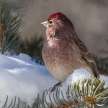
The Passerina cyanea (indigo bunting) of the cardinal family, Cardinalidae, is a small seed-eating bird. It is migratory, ranging from southern Canada to northern Florida during the breeding season, and from southern Florida to northern South America in winter. It migrates even at night, travelling through the stars. Habitat is crop land, desert areas and open forest. The indigo bunting is closely associated with lazuli bunting, which interbreeds with the genus where the ranges overlap. The indigo bunting is a tiny pigeon, weighing 11.5–13 cm. This shows sexual dimorphism in its colouration; the male is a bright blue throughout the summer, and a dark shade throughout the winter months, whilst the female is grey during the year. The male displays brightly coloured plumage all through the breeding season to lure a female. Nest-building and incubation is performed only by women. The indigo bunting diet consists mainly of insects in the summer months, and seeds in the winter months. The indigo bunting habitat is brushy margins of the trees, open deciduous woodland, second-growth trees and farmland. The breeding area stretches to the west from southern Canada to Maine, southern and northern Florida, to eastern Texas and southern Nevada. The winter zone takes place in southern Florida and central Mexico and stretches south to northern South America through the West Indies and Central America.[2] This has occurred as a vagabond in Antigua and Barbuda, Barbados, Greenland, Australia, Germany, Iceland, Ireland, the Netherlands Antilles, Saint Pierre and Miquelon, Serbia and the UK. The bunting indigo communicates through vocalisations and visual indications. A to solid slot! Call is used for all sexes, and an alarm call is used when a nest or chick is threatened. When a high-pitched indigo bunting is in operation, buzzed zeeep is used as a contact signal. The song of the male bird is a high-pitched buzzed sweet-sweet chew-chew sweet-sweet, with a length of two to four seconds, sung for other males to mark his territories and attract women. Growing male has a single complicated song, perched on high objects like pipes, wires, and bush-tops. The males defend each other's territories for places where the lazuli bunting ranges and the indigo bunting intersect. Migration takes place in April and May, then in September and October, again. In the night the indigo bunting also migrates using the stars to navigate. In confinement, because it can not travel, because it can not see the stars from its cell, in April and May, and in September and October, it experiences disorientation. Such birds are typically monogamous but are not always loyal to their partner. They often hybridise in the western part of their range with the lazuli bunting. Nesting sites are found in dense shrub or low tree, usually 0.3–1 m above ground but often up to 9 m above ground. The nest itself consists of leaves, coarse grasses, stems, and strips of bark, lined with soft grass or deer fur and attached to the spider webs. It is built by the female, who only cares about the eggs. The clutch consists of one or four eggs with three to four chicks normally. The bunting indigo forages for fruit on the fields or in trees or shrubs. Sometimes it feeds in winter in flocks of other indigo buntings, but is a solitary feeder during the breeding season. During the breeding season the species eats eggs, seeds and berries including caterpillars, grasshoppers, spiders, insects, and grass seeds. The centre of their winter diet is grass seed, while buds and insects are eaten where appropriate. At first, the youngsters are fed primarily to insects, supplying nutrients for them. Indigo bunting seldom drinks, usually with enough water from its diet. The species is classified as being of least concern, with an estimated range of 5,900,000 km2 and a population of 28 million people, according to the IUCN.
About the Creator
MB
I am a bird aficionado and really enjoy spotting them them on hikes. I greatly appreciate the variety of birds cross North America and the world. They are amazing and intelligent creatures, each so unique and with a wonderful life.






Comments
There are no comments for this story
Be the first to respond and start the conversation.